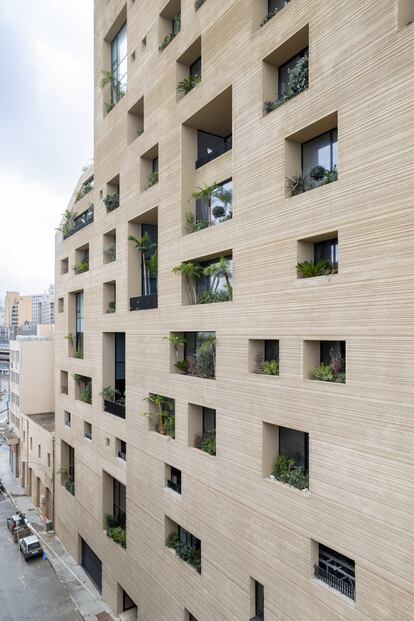Between archeology and landscaping, with a facade combed by artisans, this building built with the memory of a childhood before the civil war, is the opposite of an anonymous property.
The first project raised by the architect Lina Ghotmeh (1980) in her hometown, Beirut, has added the Shelling Prize to a string of recognitions.
And if all the laurels are important, the Shelling (previously awarded to Anne Lacaton and Jean-Philippe Vassal, Francis Kéré or Kazuyo Sejima) is even more so because it highlights “architectural works designed to improve the future”.
Why does the Ghotmeh skyscraper speak of the future?
Possibly because, from the outset, it recognizes, and neither erases nor mythologizes, the past: it tries to digest it.
And from there, point to optimism
More information
What is left of Beirut's flourishing architecture?
Established in Paris for almost three decades, Lina Ghotmeh remembers Beirut the ruined city of her childhood in which the remains of the buildings were invaded by nature.
Fragile by the bombings, bullets and deterioration, he assures that the buildings had become fertile ground for the plants.
That idea, that of nature that heals, invades or simply breaks through, was what he sought to recreate with the tower of flats that he baptized as the stone garden (Stone Garden).
There, a few meters from the industrial port and surrounded by single-family homes, the property speaks of a necessary but also rational growth.
Thoughtfully thought out, it's built almost by hand with room for people to do more than just sleep and work.
The building meeting the street angle Iwan Baan Photography
The concrete of the façade is mixed with local earth to settle the new skyscraper also epidermally in place.
The façade is handcrafted by craftsmen who turned concrete into a textured, malleable material capable of telling a story.
The architect wanted a tall but rooted building, a place of the future but related to nature.
The result is a rectilinear but organic building, a forceful but flexible skyscraper-mountain.
It is a tower that seems to salute, while giving space, and obediently lines the street when it reaches the corner.
Thus, powerful but porous, the property neither ignores the history of the place nor that of recent events.
That is why it evokes the earth, it opens and protects itself at the same time.
Dialogue with the memory and with what is to come.
Detail of the rough and combed facade of concrete and sand Iwan Baan Photography
"It is a tower of life and death", explains the architect.
And remember that the building occupies the old site where the first Lebanese cement company was built in the industrial port of Beirut.
Its architect, Pierre El Khoury, had his office there and his son, the photographer Fouad El Khoury, was the one who decided to build an iconic but earthly skyscraper on the site of the ruins of his father's building, a dialogue between past and future of the place.
Architect Lina Ghotmeh, winner of the Shelling Prize.
The result is landscaping, architectural and sculptural.
Handmade, it recalls a mountain emptied by burrows of precise geometry.
Staggered and set back, he speaks more of individuals than of masses.
It is dense and compact but not inhumanly anonymous.
It has a presence but does not silence others, it allows the rest of the members of the neighborhood to participate in the living dialogue that a city should be.

